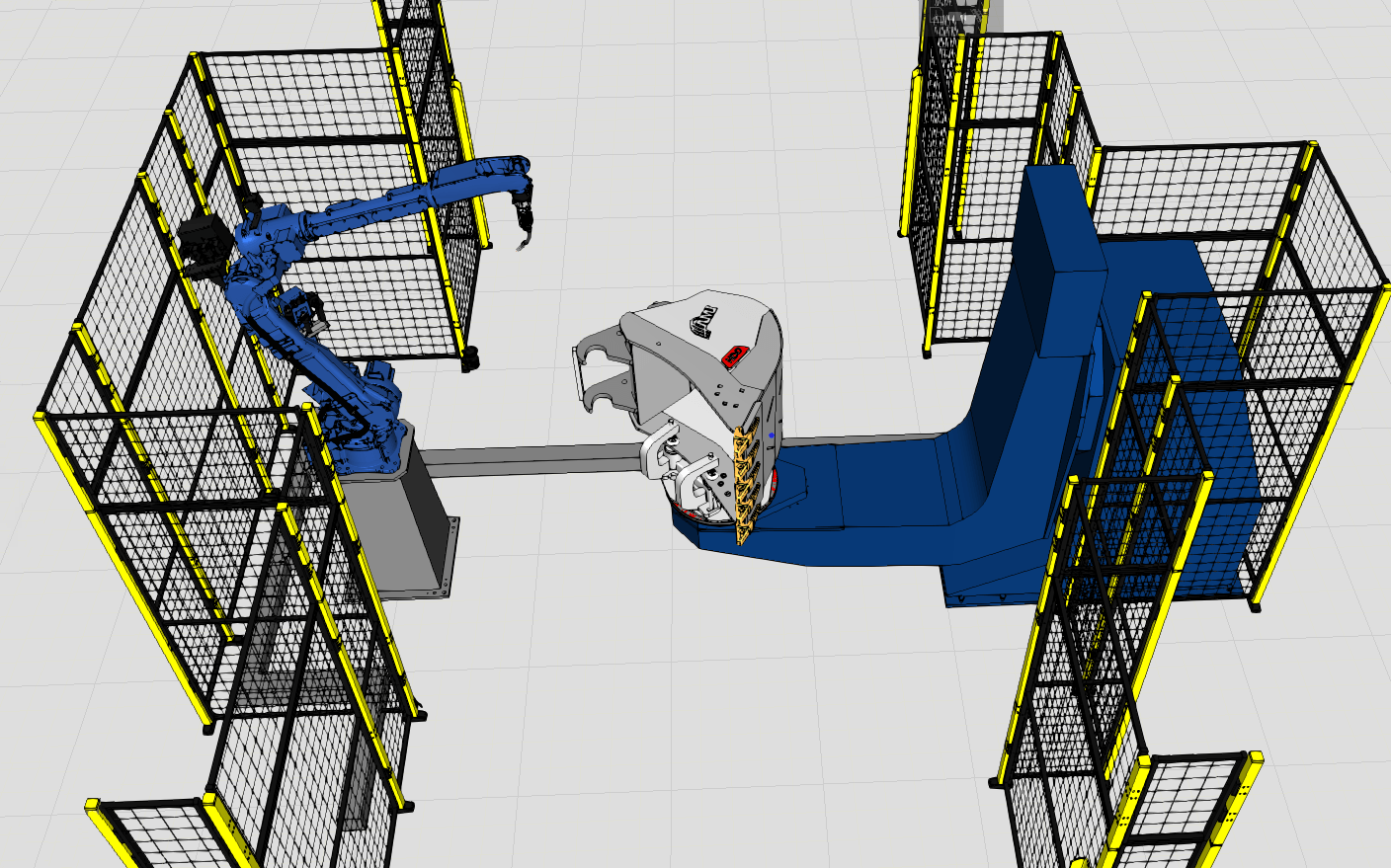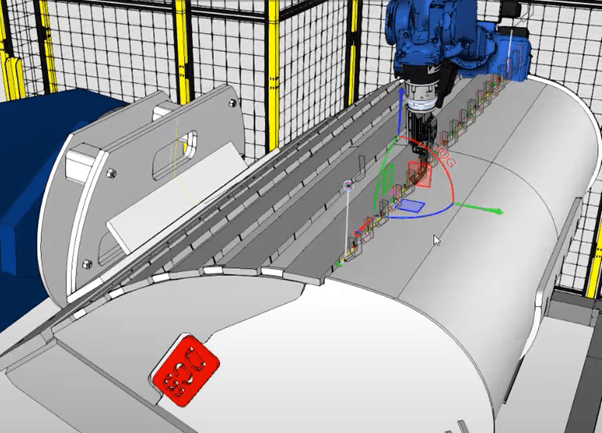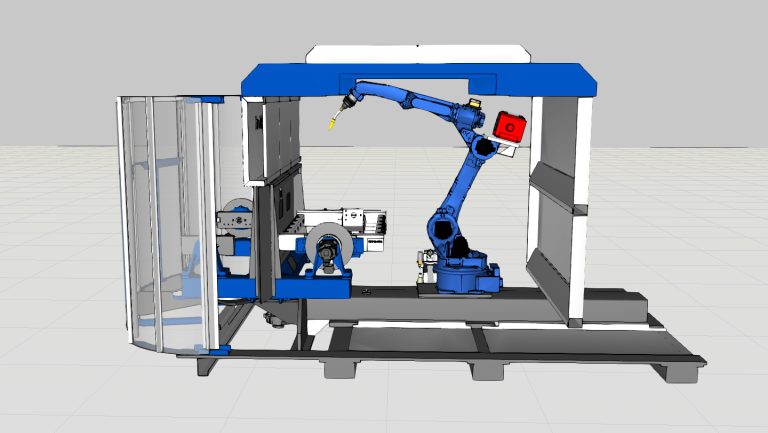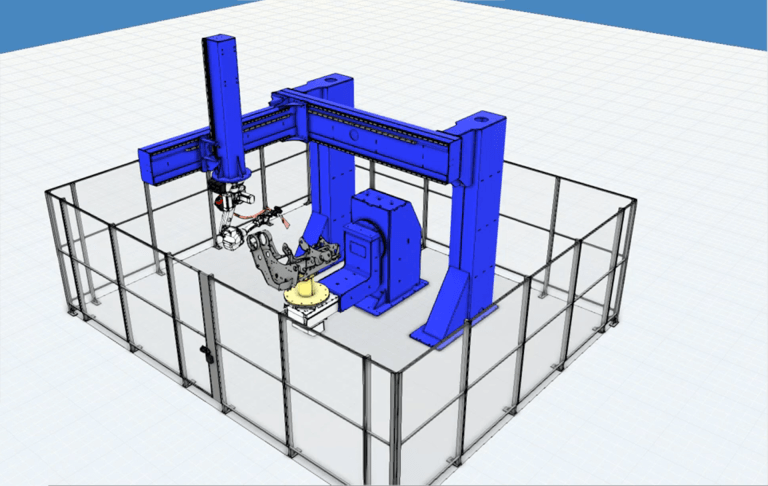Combatting the welder shortage: how AMI Attachments enhances production efficiency with Visual Components OLP
AMI Attachments, a leading North American manufacturer of heavy equipment attachments, sought to improve product throughput and meet evolving market demands while navigating a welder shortage. By implementing Visual Components OLP software, AMI reduced programming time by 70% and enhanced production efficiency and quality.

Pioneering customer-centric construction equipment innovation and growth
AMI Attachments (AMI), a leading North American manufacturer, is renowned for their high-quality, reliable heavy equipment attachments. Founded in 2001, they have grown from a 1,393 sq. m. (15,000 sq. ft.) shop to a 9,290 sq. m. (100,000 sq. ft.) facility. AMI is committed to helping customers increase productivity with top-tier products and exceptional customer service.
Navigating welder shortage with robotics and offline programming
Facing evolving market demands and a welder shortage, AMI introduced a Panasonic robot to their MIG welding process. However, manual robot programming was time-consuming and prone to errors, especially in high-mix, low-volume production. The shortage of skilled welders further compounded these challenges, leading to downtime and inconsistent weld quality.
To streamline the robot programming process and alleviate employee workload, AMI implemented Visual Components OLP for offline programming. PJ Muker, Robotics Supervisor and Lead Programmer at AMI, oversees the Robotics Department, ensuring that their robotic solutions meet production goals. His team handles robot programming and maintains a smooth workflow by preparing workpieces and managing production tasks.
While robotics aren’t ideal for high-mix and low-volume, offline programming with Visual Components helps us streamline and speed up robot programming.
PJ Muker, Robotics Supervisor and Lead Programmer at AMI
With the support of Mach Machines, Visual Components’ North American partner, AMI successfully transitioned to robot offline programming (OLP). Tailored training programs ensured that AMI’s robot programmers could maximize the potential of Visual Components OLP. Remote and onsite calibration minimized downtime, ensuring smooth operations and accurate robotic setups.
Anytime I have questions, I just reach out to Visual Components support, they’re always willing and happy to help. It’s been a great experience.
PJ Muker, Robotics Supervisor and Lead Programmer at AMI
Following the integration of Visual Components OLP, AMI commissioned five additional Yaskawa welding robots. Using any of Visual Components OLP’s 17 robot post-processors, AMI can easily translate programs into different native languages and download them to physical robots for real-time execution, enhancing flexibility and efficiency.
Optimizing robot offline programming workflow for efficiency
Since adopting Visual Components OLP, AMI has streamlined their OLP workflow for seamless collaboration and greater efficiency:
- CAD file preparation: Upon identifying a job scheduled for the robots, the robot programmer retrieves the job number and its corresponding CAD file, then constrains the part in Autodesk Inventor software using calibrated robot fixtures.
- STEP file export: The programmer exports the CAD model as a STEP file and imports it into Visual Components OLP. See the full list of supported CAD files here.
- Programming and collaboration: The part is then attached to the robot positioner, initiating the programming phase. The programmer includes comments and sets alarms and timers to notify robot operators about part specifications or any pertinent information, such as pre-heating requirements.
With hands-on experience in various robot offline programming software, PJ’s team appreciates Visual Components OLP’s excellent user experience and realistic graphics. The ability to save and reuse robot programs with the weld template has reduced programming time for similar parts and enabled swift adaptations for multiple parts.
These kinds of smart functions really help reduce the tediousness of robot programming. You could program this entire bucket in a few days. To do this online, it would take at least a week or two because of how slow the robot moves when you’re teaching and because of how large this product is and how much is involved with programming this entire thing. We really save weeks of time by doing this offline, it’s really, really helpful.
PJ Muker, Robotics Supervisor and Lead Programmer at AMI

Stitch welding at AMI was once a lengthy process, with programming on the teach pendant taking up to a full day for smaller parts and over two days for larger ones. With Visual Components OLP, programming times dropped to 4 to 7 hours for smaller parts and 14 hours for larger ones. The robot offline programming software also reduced the time for a 20-stitch weld from 1-2 hours to just 10 minutes, allowing simultaneous handling of multiple welds. This improvement greatly boosted efficiency and eased operational strain.
Creating and verifying a program completely from scratch on the shop floor would take at least two weeks. I can do this offline in a few days. After sending it out to get verified and touched up, we’re looking at a total of about four days. This means we gain about a week and a half. It’s a lot more repeatable, accurate and efficient. The program is clean, easily readable by everyone and everything is a lot cleaner and straightforward.
PJ Muker, Robotics Supervisor and Lead Programmer at AMI
Maximizing quality and minimizing downtime
The use of Visual Components OLP has greatly improved weld consistency and reduced defects such as porosity and burn-throughs. For uneven metal parts, the search feature enables precise weld seam identification, ensuring accuracy in complex, lengthy programs.
The shift to offline robot programming has also increased production capacity by minimizing downtime, allowing AMI to accept more customer orders and maintain high-quality standards. This approach frees up robot operators to focus on other tasks, further enhancing productivity.
For optimal uptime, AMI uses Visual Components’ PC-based offline programming platform. With an extensive model library and built-in functions that facilitate safe, timely and cost-effective robot job creation, this tool enables high-detail simulation. Moreover, it serves to build programming proficiency and a knowledge base that can cultivate maximum benefit from this workcell and others installed on the factory floor.
Combatting the welder shortage with robotics and automation, Canadian Fabricating & Welding
Upskilling welders for robot program verification
When AMI first introduced robotics into their welding process, some welders were hesitant, as robots were uncommon in their shop. However, as the technology became more integrated, the team grew comfortable, with many seeing the benefits firsthand.
To bridge the gap between traditional welding and robotics, several welders transitioned to robot program verification roles. Their hands-on experience allows them to correct collisions, adjust torch angles, and finalize products efficiently.
Having people with hands-on skills and knowledge from working on the floor manually, combined with the robotics side, helps speed everything up, makes everything safer and more efficient.
PJ Muker, Robotics Supervisor and Lead Programmer at AMI
By embracing advanced technology and robot offline programming, AMI continues to lead the industry in manufacturing high-quality attachments. Their innovative approach has attracted attention from other high-mix, low-volume manufacturers and solidified their position as a role model in combating the welder shortage while improving production efficiency and quality.
About Visual Components
Founded by a team of simulation experts and amassing over 20 years in business, Visual Components is one of the pioneers of the 3D manufacturing simulation industry. The organization is a trusted technology partner to a number of leading brands, offering machine builders, system integrators and manufacturers a simple, quick and cost-effective solution to design and simulate production processes and offline robot programming (OLP) technology for fast, accurate and error-free programming of industrial robots.
Want to learn more about the benefits of our solutions for your business? Contact us today!
Further reading

Maximizing efficiency and ROI from day 1: Duun Industrier pre-programs a welding robot cell with Visual Components OLP
Duun Industrier, a leading Norwegian heavy machinery manufacturer, installed the Nordics’ largest robotic welding station in 2013. Utilizing Visual Components for robot programming since 2014, they commissioned a new robot...

Ponsse is driving forest machine innovation and improving productivity with Visual Components Robotics OLP
Ponsse Plc., a global leader in forest machine manufacturing, has transformed its production process by leveraging Visual Components Robotics OLP.

AFRIT production runs faster than ever, thanks to Visual Components Robotics OLP
Read how a trailer manufacturer from South Africa improved the manufacturing efficiency by using Delfoi Robotics Offline Robot Programming solution (Now known as Visual Components Robotics OLP).